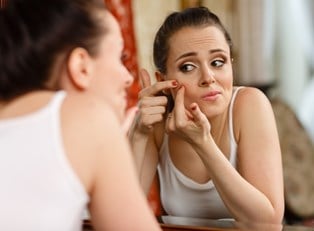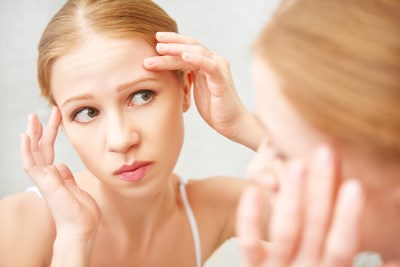Nobody likes pimples, but everybody gets them. While you are probably quite familiar with the blackheads that never quite seem to go away and the whiteheads that show up in the center of your forehead every time you've got a social engagement, there’s actually four other kinds of pimples—and they’re even more painful and difficult to get rid of.
Pimple Causes
Even when your face is perfectly smooth and clear, you may still be able to see microscopic spots. These are your pores; everyone’s are different-sized, some more visible than others. Regardless, each pore has a little pathway through it that lets sebum (the oil that sebaceous glands produce) flow out to the top of the skin.
Although a lot of people go out of their way not to have oily skin, when it is produced at the right rate, sebum keeps your skin smooth and prevents it from drying out. When hormones start going crazy, so does oil production. Your pores can’t get rid of it fast enough, and it starts to get stuck inside and block them up, along with dead skin cells and bacteria, until a pimple forms. Exactly what kind depends on what else occurs inside the pore from there.
Non-Inflammatory Pimples
Non-inflammatory pimples, also called comedones, are your standard blackheads and whiteheads. The difference is subtle (even if their appearance isn’t always). Blackheads are a blocked pore that stays open. You can actually see what looks like a pinprick of dirt nestled inside, because the stuff blocking the pore has oxidized and gotten darker.
Sometimes, the pores close over once they become blocked. Their tip may be different from the surrounding skin, but only by a slight redness or whitish tip. Since the oil isn’t subjected to air, it retains its natural color beneath the skin, which is why they are called whiteheads. Some people get blackheads or whiteheads rarely, while others fight a constant barrage.
Inflammatory Pimples
If the walls of the pore get so irritated that they burst, papules and pustules form. Papules are hard to the touch, and can feel sore. When the walls rupture, inflammation is caused by the bacteria inside, and eventually the resulting yellowish pus-like liquid inside will rise to the surface, causing a pustule. Comedones can usually be managed with face wash or creams, although blackheads can be very difficult to get rid of. Papules and pustules can be a little more difficult, especially when the form en masse, and they may require a prescription facial cleanser.
Nodules and cysts are a less common form of inflammatory acne, but they can much more difficult to get rid of. Nodules are hard, and cysts are soft, and they are considerably larger and more painful than the other four kinds. They develop as the blocked pores become even more irritated. Cysts are fluid filled, but they form deep in the oil producing gland under many layers of skin; nodules can have fluid in them, but they are mostly composed of inflamed tissue—sometimes only that. Given time, they generally get worse instead of better. Over the counter products won’t even begin to help with them, and sometimes they have to be surgically removed by a doctor.



